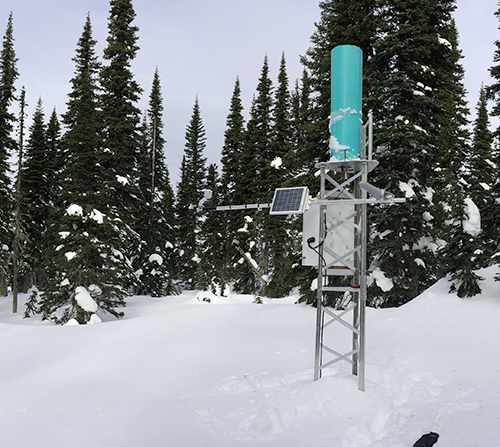Automated Snow Weather Stations
 Automated Snow Weather Stations (ASWS) are weather stations that are installed and maintained to capture four main parameters:
Automated Snow Weather Stations (ASWS) are weather stations that are installed and maintained to capture four main parameters:
- snow water equivalent (SWE),
- snow depth (SD),
- cumulative precipitation (PC), and
- ambient temperature (TA).
Some stations are also equipped to record relative humidity (RH) and have secondary ambient temperature sensors, Snow Depth sensors or Snow Water Equivalent sensors (TA2, SD2, SW2 and so on). ASWS’s are generally located above valley bottoms from the subalpine to treeline, at elevations between 700 m to 2200 m above sea-level. The high-elevation weather data produced from these sites is used by a variety of public and private agencies for purposes such as: river and flood forecasting, hydroelectric power generation forecasting, dam and dike management and avalanche forecasting.
View a list of active automated snow weather stations
Snow water equivalent, or the amount of water contained in the snowpack, is the most difficult of the parameters to measure and has traditionally been measured using snow pillows. Snow pillows are three metre diameter polyurethane pillows, filled with anti-freeze and water, which measure the amount of water in the snowpack through the hydrostatic pressure of snow sitting on top of the pillow. As snow accumulates on the pillow, the weight of the snow pushes an equal weight of the antifreeze-water solution from the pillow up into an open standpipe. The distance the antifreeze is pushed up the standpipe relative to the zero value is equal to the SWE in the snowpack. More recently, snow scales have been used to measure SWE. Snow scales work essentially the same as a large bathroom scale and measure the weight of the snow directly which is then converted into a traditional SWE value.
Snow depth is measured using an acoustic distance sensor that usually sits 3 – 5 metres above the ground and measures the elapsed time between emission and return of an ultrasonic pulse to determine the distance to the snow. A simple calculation is performed from the summer zero value to then produce the current snow depth.
Cumulative precipitation is measured using large diameter Precipitation gauges fitted with pressure transducers installed on the bottom of the pipe. The pressure transducer measures the pressure of the total amount of fluid in the pipe and converts it into a value of equivalent height of water. To prevent the contents of the precipitation gauge from freezing, precipitation gauges are drained and partially filled with a mixture of propylene glycol and ethanol in the summer and the spring.
Ambient temperature is recorded using a temperature probe housing inside a radiation shield and mounted away from any object which might affect accurately recording ambient air temperature, such trees or buildings. Sometimes these probes are also able to measure relative humidity.
Data recorded by the various sensors is captured by a small computer called a data logger and transmitted via antenna to a NOAA GOES satellite (Geostationary Operational Environmental Satellite), which then passes the information on to a central server from which it is captured by the Government database.
Various partners operate ASWS’s in BC including BC Hydro, Rio-Tinto Alcan, Metro Vancouver, The Ministry of Environment and Climate Change Strategy, The Ministry of Forests, Lands and Natural Resource Operations and Rural Development, as well as some private mining and oil and gas operations.
